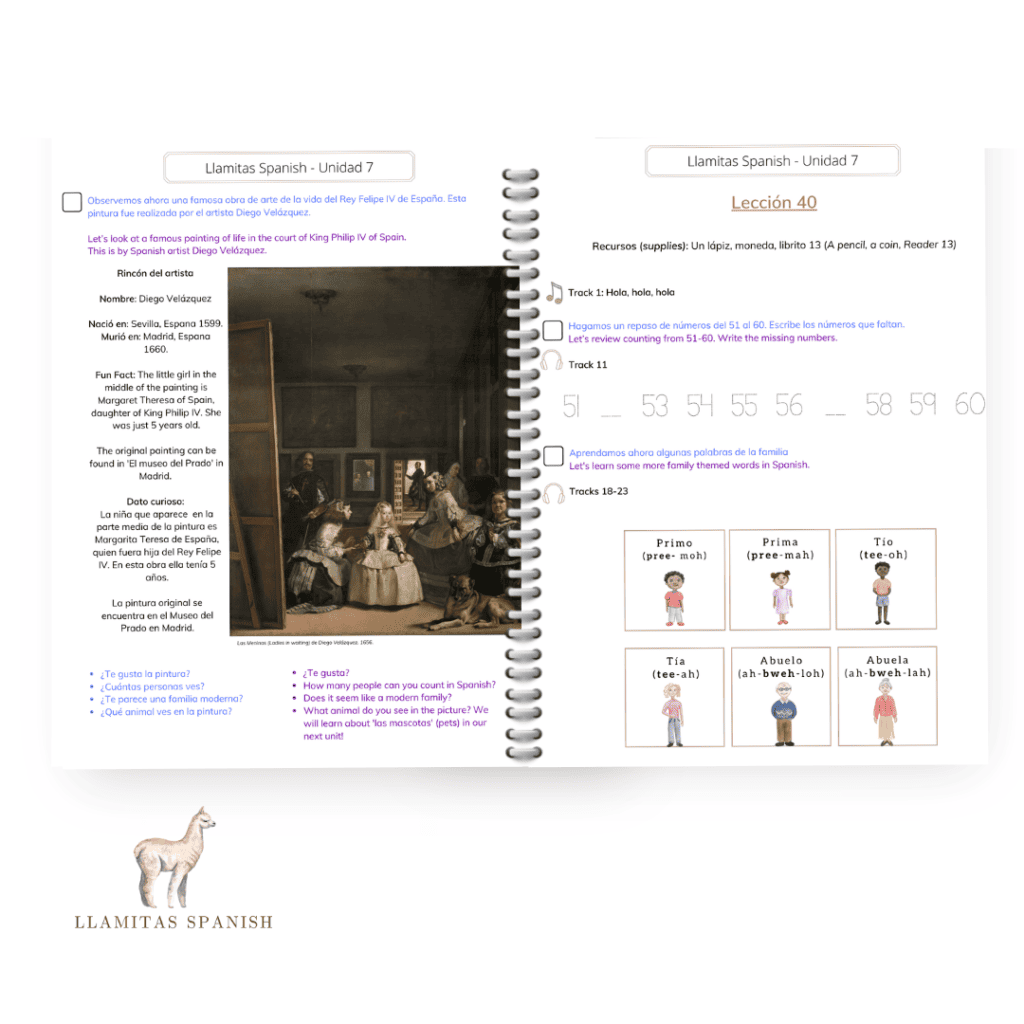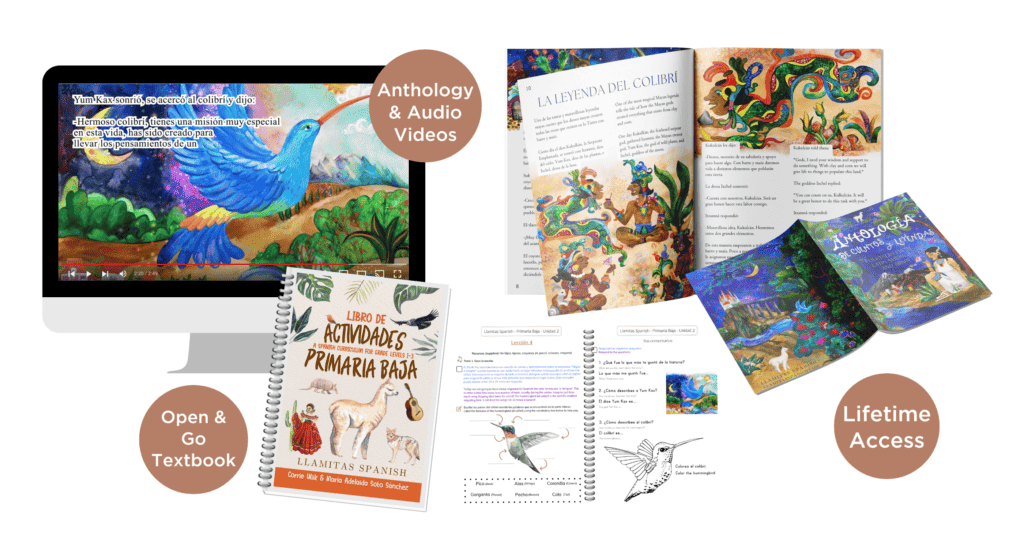In this post: Learn about the Charlotte Mason method for foreign languages and how you can use it to teach your child Spanish at home.
You may have heard of the Charlotte Mason method for homeschooling, but did you know this method can be applied to language learning too?
In fact, Charlotte Mason held strong beliefs about teaching foreign languages, many of which can easily be applied to a homeschool Spanish curriculum.
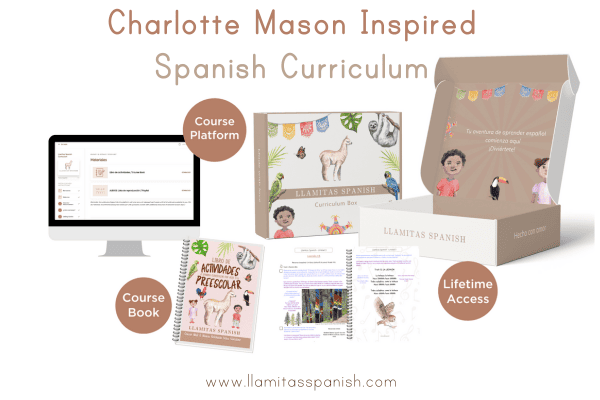
This post contains affiliate links. As an Amazon associate I earn from qualifying purchases.
At Llamitas Spanish, we aim to give your child an authentic Spanish learning experience, and we’ve adopted many of Charlotte Mason’s methods to do this.
Whether you’re set on a Charlotte Mason Spanish curriculum or are just dipping your toes in the water, we’re here to support you. Let’s find out a bit more about how you can teach your child Spanish using the Charlotte Mason method.
Table of Contents
Who was Charlotte Mason?
Charlotte Mason (1842–1923) was a renowned British educator, known for her contributions to children’s education. Her methods paved the way for the Charlotte Mason approach to homeschooling that’s still so popular to this day.
Mason believed in educating the whole child and creating a positive learning environment to nurture children’s natural love of learning. Her holistic approach to education has a focus on liberal arts and is used to teach children in all subjects, from foreign languages to math and science.
Music, art, and literature are extremely important in the Charlotte Mason method.
She was passionate about the use of high quality literature, or what she called “living books,” in a child’s education, as well as artist and composer studies. She believed strongly in children’s ability to appreciate art and literature and that these types of studies feed their minds.
Related post: Living Books (Libros vivos) in Spanish
At the same time, the Charlotte Mason method allows children the freedom to pursue their own interests. Mason provided her students with a structured, teacher-guided curriculum but also encouraged self-education. She saw children as individuals—or “persons,” as she’d say—but aimed to provide them with the tools and knowledge needed to grow as people.
Charlotte Mason Method for Foreign Languages
A Charlotte Mason foreign language education will incorporate a few key elements—a focus on speaking and listening; using the Gouin Series method; and studying art, music, and literature.
“(Foreign languages) should be acquired as English is, not as grammar but as living speech.” –Charlotte Mason, Home Education p. 300
In her book Home Education, Mason outlined some of her key beliefs regarding foreign language acquisition:
- Living speech: With Charlotte Mason, foreign languages aren’t taught through grammar, but as what she called “living speech.” She placed an emphasis on experiencing language naturally, applying it to everyday actions.
- Listening and speaking: Mason believed that children should master listening and speaking skills before even seeing words in print, much like how children naturally pick up their first language at a young age, before they can read.
- Vocabulary: She also said that vocabulary should increase steadily each day, giving the example of about six words a day as a good number to aim for. Learned vocabulary should be practiced regularly and in sentences.
- Pronunciation: Mason believed students should gain what she called a “pure accent” through exposure to native speakers of the target language. Again, she believed that listening and speaking before reading was essential to this.
An important part of the Charlotte Mason method for foreign languages is the Gouin Series method. This technique was developed in the 19th century by François Gouin, a french educator specializing in foreign language instruction, and Mason saw that it aligned well with many of her beliefs.
In particular, she agreed with the idea that we should learn new languages in the same way that children acquire their first language.
This is where the idea of the Gouin Series comes from. Practicing sentences—first hearing and then speaking them—in a natural, logical sequence allows students to begin to think in their target language (Spanish, French, etc.).
Here’s how a Gouin Series works:
- First, the teacher chooses a scene or scenario to demonstrate. For example: building a fire, baking a cake, going out for dinner, etc.
- The teacher speaks in short sentences—each containing a concrete action—to describe the series of events. For example: I drive to a restaurant. I enter the restaurant. I sit down at a table. I order dinner. I eat my food. Note: While stating each sentence, the teacher will pantomime and/or use props to demonstrate the action.
- Next, the teacher will repeat this process again, this time with the students pantomiming the actions.
- The class will then practice saying each action and pantomiming together.
- Finally, each individual will perform the entire process on their own.
You’ll notice that statements are kept short, must contain a verb, and follow a logical timeline. They’re also generally kept in one tense with one subject. This is a practical way to introduce new words and phrases and put them into use right away!
Studies of art, music, and poetry were also essential to Mason’s approach, and should be incorporated into a Charlotte Mason foreign language curriculum, which we’ll dive into next.
Related post: 70+ Useful Spanish Homeschool Phrases
Cantos / Recitations
While not a purely Charlotte Mason curriculum, Llamitas Spanish® adopts many of Mason’s practices, including recitations in every unit with audio for accurate pronunciation. Having this exposure to a native speaker is essential to the Charlotte Mason foreign languages method.
For example, in Level 1 Unit 3 of our curriculum, students learn a simple memory verse called “La lechuza” (The Barn Owl) with native speaker audio:
| La lechuza La lechuza, la lechuza, Hace shhh, hace shhh Todos calladitos como la lechuza, Hace shhh, hace shhh |
The Barn Owl The barn owl, the barn owl Goes shhh, goes shhh Everyone quiet, like the owl Who goes shhh, who goes shhh |
In Level 2, students will level up to reading and reciting poetry, such as “El colibrí” by Alejandro J. Díaz Valero in Unit 2:
Canciones / Songs
Each curriculum level and unit also includes beautiful songs for your children to listen to and learn. The audio performances are a cappella to allow your child to hear the pronunciation accurately and so they can sing along with their focus on the sounds of the words.
In level 1, students will learn dozens of traditional Spanish nursery rhymes that correlate to the unit themes. For example, in unit 2 about the farm they will learn the classic song ‘Los pollitos dicen’.
In Primaria Baja Unit 2, students will continue to learn beautiful songs related to the curriculum themes. One example is “Pajarito que canta” from the birds unit. Here’s a sample of the song with audio:
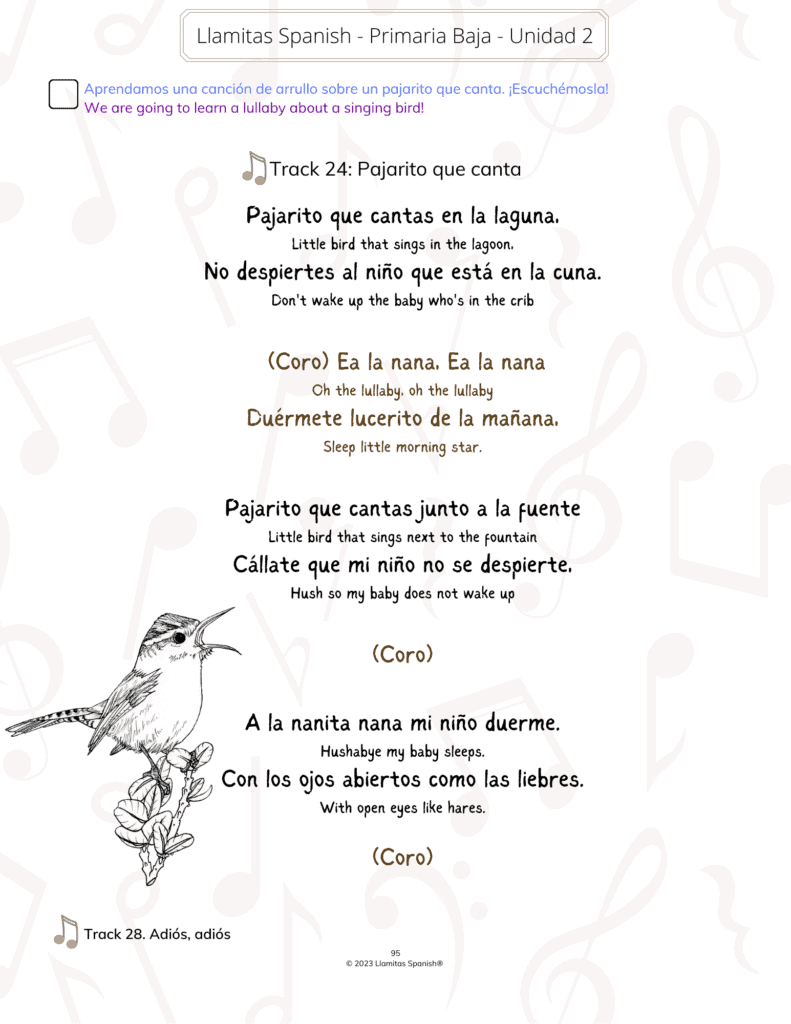
Artist Studies
Artist studies are going to play a critical role in any Charlotte Mason Spanish curriculum. In each Llamitas Spanish unit, students will study famous Hispanic artists and their work.
Each obra de arte (work of art) is studied within the context of the unit’s theme, as part of our overall thematic approach to learning Spanish. In Unit 2, for example, we look at the work of Francisco Goya in the context of the farm, encouraging skills of observation, giving opinions, and comprehension.
In our Level 2 curriculum, students discover the work of Antoni Gaudí and are able to learn about his life and architectural work in Barcelona. They can even complete their own version of El Drac, a famous landmark made with trencadís (broken tile mosaics) found in Parc Güell.
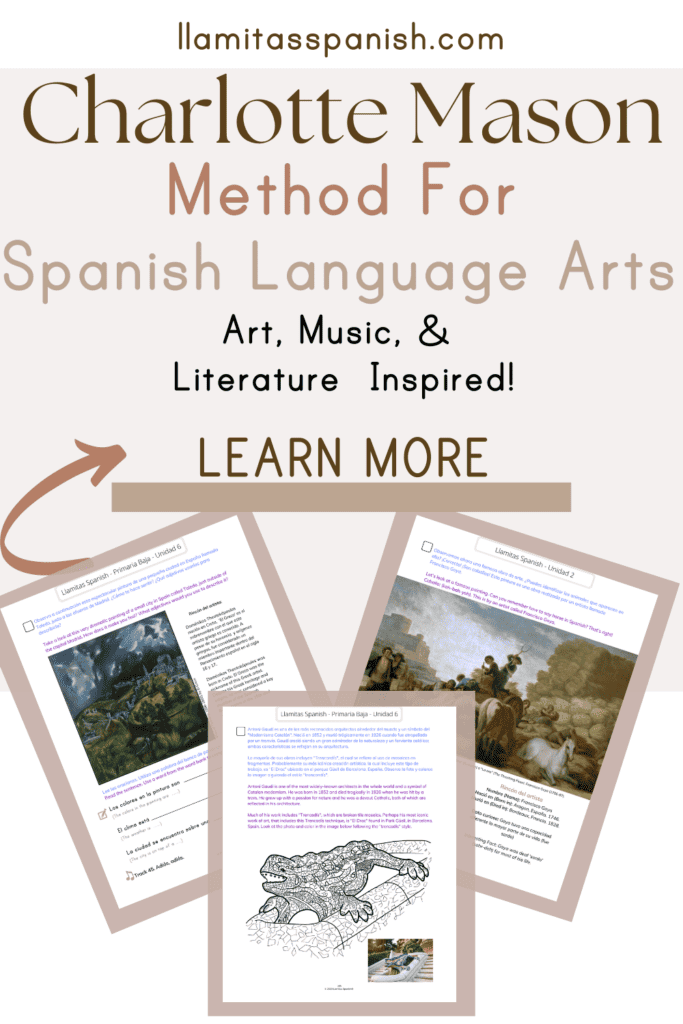
Related post: Elementary Homeschool Spanish Curriculum
Teaching Spanish with Living Books
A Charlotte Mason Spanish curriculum wouldn’t be complete without including high quality, beautifully illustrated literature—what Mason called living books. She believed these books fostered a lifelong love of reading.
This kind of high quality literature is at the heart of our Llamitas Spanish curricula.
Starting in Level 1, we have a series of short stories, along with relevant comprehension questions. In Level 2, students dive deeper into stories through an authentic anthology that is rooted in timeless Hispanic folktales, all beautifully illustrated and supported with native speaker audio.
Each story in our anthology is engaging and entertaining for young readers. Is your child interested in castles with noble steeds? Or maybe they’d be more interested in a tragic romance between an Aztec warrior and princess. There are stories for the nature and animal lover as well!
But these folktales aren’t just fun (although that’s important too!)—they’ll be learning about the values, culture, and history of Spain and Latin America. These living stories are enriched by comprehension activities, copywork, and creative writing tasks.
Related post: Supporting Biliteracy Through Elementary Spanish Stories
Llamitas Spanish Curriculum
If you’re educating your children using the Charlotte Mason method and are ready to incorporate a foreign language into your homeschooling, our Llamitas Spanish curriculum will make the process seamless.
While not strictly a Charlotte Mason Spanish curriculum, at Llamitas Spanish, we’ve designed our lessons and materials with many of Mason’s beliefs and principles in mind.
Studies in art, music, and literature are at the heart of both our Level 1 and Level 2 curricula. Our thematic lessons allow your child to learn Spanish naturally and in context, applying it across subjects.
Even if you don’t speak Spanish yourself, our native speaker audio provides students with ample opportunities for authentic Spanish input—working those listening skills and ensuring correct pronunciation.
With these Charlotte Mason inspired methods, your child can learn Spanish naturally and put it into practice right away!
>> Learn more about Llamitas Spanish by visiting our curriculum shop!
Related post: Comprehensible Input: Unlocking Language Learning for Children


